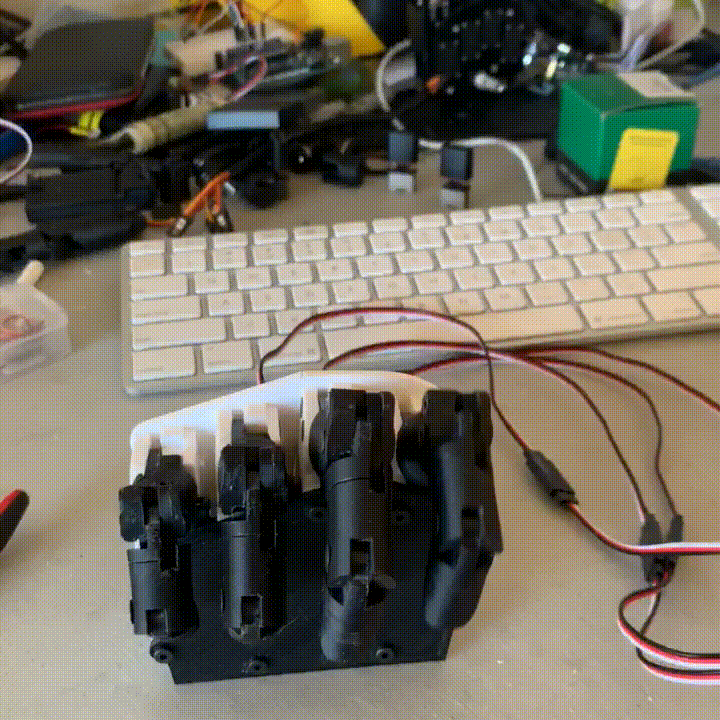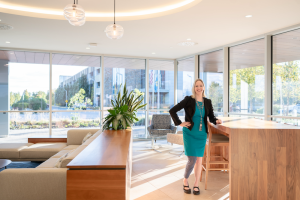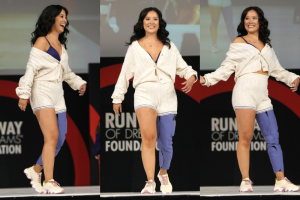The fifth episode of CIONIC’s podcast Superpowering the Human Body, features a conversation with Industrial Designer, Daniel Zarem.
Daniel shares with us his passion and process for designing products to augment human function. We discuss how advances in materials, sensing, ML, and manufacturing are accelerating a future of highly personalized solutions.

Watch on YouTube
The full transcript is below, edited for readability.
Jeremiah: Jeremiah: Hi, my name is Jeremiah Robison founder and CEO of CIONIC. We build bionic clothing to enhance human performance and overcome disability. Welcome to another episode of Superpowering the Human Body, where we explore the science and technology of human augmentation.
A few weeks ago, we spoke with a researcher out of MIT talking about neural-controlled prosthetics and her research doing that. One of the things that she really emphasized was this idea of design thinking within assistive technologies. I decided I’d reach out to my good friend Daniel Zarem, an Industrial Designer with a passion for prosthetics and invite him on the show. Daniel, thanks for being with us.
Daniel: Thanks for having me. I’m excited.
Jeremiah: Great to have you. I just wanted to start out with a set of questions. How did you get interested in Prosthetics? What is your passion for it? And how do you see design thinking applied to the world of assistive devices?
Daniel: Great few questions. I’ve kind of approached this throughout the past six years of my career from a couple different angles. I originally got really excited when wearables started coming out, because I saw a lot of opportunities for the mentally and physically impaired to be helped out by the small technology on the body. At the time, the industry wasn’t quite mature enough to bring all of those components together in a system. So I started looking for other ways that I could help out. At the time, I worked for a few months in a cafe run and operated by the disabled, and got to really get some great first-hand observation and interaction with how a lot of these impairments can affect, not just daily life, but all sorts of other activities that we take for granted. So, that stoked the fire even more and I just wanted to use technology to really assist people who could use it in any way shape or form.
So, a while after that I got very into the idea of humans out in space thriving — not with the bare essentials and running only experiments — and as we start to get closer to space tourism that excitement grows more. So, linking the two; from the space side and needing robotics and very intuitive control through biometrics and then the other side, of people right now missing arms and hands of all sorts of different ages that are in this predicament without great ways to solve it.
So trying to really narrow all of my efforts to something that kind of pushes both goals forward a lot more and gets us one step closer to the sci-fi dream I have in my head and helping people here on the earth presently.
Jeremiah: It’s fascinating to think about the collision of those two interests and the idea that when we think about technology and technology as an enabler, the future might be that all humans are augmented in various ways. And then, when it becomes everybody’s opportunity then maybe we would not leave behind as many folks.
Now you talk about the fact that this journey started working in a cafe with folks who did have their own physical impairments. We talked a lot about what the human needs, the customer needs of these products are. Talk about that process and how that sort of guides your design as a whole.
Daniel: Typically in a design project, we will start with a real heavy strategy phase. So the goal is to really build our design foundation and understand, a very clear picture of who this user is actually. Not what the statistics of their purchasing suggest that they are, but who they actually are, how they operate or interact with whatever category it is that we’re designing for.
So, if it’s robotic furniture, then we’re looking inside the home and how people are using their space. If it’s bionic prosthetic, we’re looking at how the impairment or the lack of a certain portion of the limb affects opening a jar, for example. I mean, that’s a typical thing that we can do easily, but it’s very difficult for many people to thoroughly empathize with that from the second they wake up in the morning until the time they go to sleep and everything that happens in between. So as designers, we have to figure out how to understand and empathize with that very effectively. We’re designing this for the whole spectrum of people using it. Ideally, if we can design and solve for the extremes then everyone in the middle gets a very valuable solution.
Jeremiah: So when we think about the landscape of assistive devices and speaking as a parent who has a child with a mobility difference, there are very few solutions. We always say the best that technology has to offer is crutches, canes, walkers, and wheelchairs. Why do you think that is and what needs to change to bring new Innovations to those communities?
Daniel: I think a lot of the reason we don’t have a wide variety of solutions at this point is really because historically there has not been very much effort to change that. I’m talking about centuries of this, that’s always been a topic that people have been uncomfortable about. I’m thinking 200 years ago, right and no one knows how to deal with it. And so there has not been much effort throughout the centuries to really improve upon that. And now we’re at this day and age where there’s a phenomenal repertoire of technological components that we can put together, and then hop online and dig into the community surrounding it, and get all the code and put it in. Of course, it’s tougher than just that but there’s a lot that you can do now on your own. And so, we’re starting to see individuals popping up…a father with a child with no hand knows basic modeling and can find enough tutorials online to get the job done, can get it 3D printed and help his kid immediately have a hand. And, maybe the functionality is not quite the same as someone who’s at John Hopkins who’s developing an arm, but it still is adding to this community of solutions, and that’s going online and other people are seeing it, and it’s really starting to kind of spread. People are starting to really understand how much we can do with what we already have. I think that’s true across all Industries. We sort of hit this place where so many sensors have gotten so small and motors and everything that we can really actually put a lot into, just for example, the palm of a bionic hand. Ten years ago, it would require an entire forearm with actuators and tendon systems and all of this. Now we can fit in the palm and the wrist, so that even itself allows for people with missing from the hand or the wrist up. They can have a prosthetic as opposed to just from the mid forearm up.
Jeremiah: I think you hit upon two really interesting factors in this: one, the technology is maturing and the commoditization both of sensing technology as well as machine learning infrastructure, allows for the sensor-driven actuation systems to shrink both in size and in cost, and as you mentioned, if you can 3D print it at home, then the accessibility of accessible technology increases. Because beforehand, a lot of these solutions were either too big, too heavy or too expensive to roll out to the general community. So, with that, tell me about some of your favorite solutions that are out there, some of your favorite initiatives that you’re seeing people take on.
Daniel: So, right off the bat it’s going to be OpenBionics. They’ve been really exciting to me for the past couple years and have really taken off. What’s really exciting about their hero arm is that it’s all 3D printed and it’s all customized to the individual. So what this allows for, they have basically opened up an entire market for themselves to help them stay afloat, but they’re providing arms to children now. Because rather than getting an entire new arm, you can just get one sleeve, remove it from the arm, put a new one in as the kid grows and that arm keeps its value for a long long time. Not only that, because they’re 3D printed, they’re far cheaper, so they’ve all of a sudden made bionic prosthesis accessible to an entire age range that it previously was not, and those are formative years. That’s far more valuable in many ways to have a kid with a bionic prosthetic that excites other kids and is cool than it is to have the kid grow up feeling ostracized in any way shape or form.
So that leads into what else OpenBionics is doing that I think is revolutionary in that industry, and that is they are not hiding anything. They’re celebrating the fact that you’re wearing an arm that is motorized and can light up and can do all these really cool things. I mean, that IS something to celebrate. Whenever people look at robotics, even just the robotic arms, most people are pretty damn amazed. It’s hard not to be, from the coordination of robotics in general is fairly mesmerizing to a lot of people.
OpenBionics has really packaged this in a way that excites people and asks for questions and interactions. Rather than people not knowing where to look at someone with an impairment — I’m sure we’ve all felt this at some stage in our life — -Now, it gives people a direct place to look and it makes people feel more comfortable asking the question about it. So I think it’s something that’s beneficial for both the people with all their limbs and learning how to kind of overcome some self…what’s the right word…I guess overcome being slightly uncomfortable by someone who isnot the way everyone that you see normally is.
Jeremiah: I do. I really do love what they have done and we think about approaching the entire problem from not just a technology aspect but from the design and the human factors need. I mean look, they partnered with Disney so that they could have an arm that was an Iron Man arm and a Luke Skywalker arm. That’s cool, right? And that’s not the technology underneath, but it really is the product as a whole. And I think too often, people like myself, technologists, bind it down into, “Oh, can we make a finger contract .. make it extend?”… and it really is about so much more than that.
You talked about additive manufacturing: 3D printing and what the opportunities that creates in terms of the products and in terms of customization. How has that changed your approach to what you build and how you design products?
Daniel: It’s actually changed quite a bit in the past year. As an industrial designer, I have been using 3D printers for over a decade now. We use it in our process to iterate, make study models, be able to test and feel “ok, this one tiny little bump actually should be two millimeters to the left.” You can only really understand these things by feeling them. So, using 3D printers that way has always been a part of the ID process. But, in the past year, I’ve been working on starting to build my own bionic prosthetic hands. I have started to need certain material properties from the 3D print …to be able to have linkages that are actuating just right, with no friction and the right tolerances and that’s something that 3D printers are always struggling with. But, for the first time I’m being able to print in ADS and have all the parts be strong enough and be moving for a long amount of time. Some of the motors that I’m using are putting about 11 pounds of force on on tiny little plastic pieces that are layered, that are not injection-molded and still, you know, they’re they’re holding strong for a good while. So, it’s exciting to start to think of 3D printers and added manufacturing as a really viable option for mass production. This is not the general mass but a sector of that, but getting to to rely on the the additive manufacturing to be able to make usable parts now and bespoke parts is something that’s really exciting and can really only be done — the bespoke aspect of it can really only be done in a wider scale through 3D printers. So it’s very exciting and a lot of people with you know, lost limbs are getting 3D scans of their limbs which are getting set for their Prosthetics. So, you know using additive Manufacturing, also allows you to take raw data from a 3D scan and quickly customize it, test it and get the right feel and fit, because hile that geometry might be just as right based on the 3D model that you’re working on, there still might be certain burrs in places or people just have more sensitive skin the certain patch and being able to quickly iterate on this allows for the right fit right from the get go.
Jeremiah: Yeah, it’s really interesting to hear you talk about how the synthesis of sensing technology — scanning technology — which again is something that used to be a two hundred thousand dollar piece of equipment. Now, your iPhone has a full LIDAR system on it so you can bring highly detailed sensing information in, reproduce it in, a 3D model and have, as you said, a completely bespoke solution and I find that future to be hugely compelling.
Now, I don’t want you to reveal anything secret, but can you tell our audience a little bit about what makes the prosthetics that you’re working on unique and special?
Daniel: My goal has been to really understand how to turn a 3D printed bionic hand into something that can be easily reproduced on essentially any 3D printer, can be easily assembled, and troubleshot and everything, to be passed around on the internet for free. I mean, you know more people need this and as an industrial designer who spent a lot of time working with Engineers on manufacturing and keeping the right design intent and feel for the user experience. It feels like I’m in this unique position to be able to really design files for an easy build for people that don’t have experience to do this and don’t have experience with 3D printers to immediately put the files on and not have spaghetti 3D print, but have proper ones that all fit together with the right tolerances to have a very clear list of parts and assembly instructions. It’s very simple. It’s a labor of love for sure because this is not for a paying client, and it’s exciting in that regard because you know, the idea is to reach a lot of people and have them build upon that ideally this can kind of snowball into a lot of different attachments for the same hand or different fingers or there’s a lot of room for that which is really exciting. And so to provide a platform that’s easily accessible for a lot of people to build, with parts that are all off the shelf and don’t require special tools or rigs to build themselves. That’s a really exciting notion to me.
Jeremiah: It’s a really interesting opportunity in that we often talk, when we’re talking about large scale production, we’ll say ‘design for manufacturing’. How do you design this product so that it can be easily produced. This is totally different, it’s more like ’how do you design for bespoke?’ Because traditionally, if you’re building a bespoke product, you’re designing it from the ground up, but if you can make a system that is modular, that can be printed at home, and it can be easily extended, well again, that unlocks a whole world of opportunity. And, I like the way that you talk about…we often talk in the software world about the open source community, but that open source model has extended into open source hardware and into open source design files. What are some of the other …you talked about open bionics … talk about some of the things, and it doesn’t have to be in the world of assistive technology.. open-source designs that have really caught fire and bloomed.
Daniel: I’ve seen some exciting projects coming out. Actually with this robotic dog; we’ve all seen the Boston Dynamics Spot robot. Well, gait on a moving robot has been figured out so much by Boston Dynamics and others in that field, that it’s coming down now into small, tabletop-sized form factor. So, now it’s allowing basically all of that information, encoding that allows for this autonomous movement and object detection and moving over it and is kind of putting that in the hands of a lot of people. So for me, that’s really exciting right now, very specifically because it sort of relates back to ‘what’s happening in space.. on Mars later’, you know, eventually all of this right? We don’t see the personal value of a robotic dog right now like we would with a bionic prosthetic but You know moving forward having this be open source right now and starting to build on this mobile platform that’s able to overcome all sorts of terrain that currently is our best robotic solution to truly all-terrain and that that’s exciting.
Jeremiah: Well, I for one welcome our robot dog overlords, which brings me to my last question. When you think about the future… 10 years from now, 20 years from now… What do you see as being the solutions for that diversity of human ability? And what is transcendent beyond that?
Daniel: Ten-twenty years from now, I’d really like to see a society across the globe that puts a lot of value on hands-on learning, doing, building and making. And, as these open source communities both in hardware and software continue to grow, and as kids in school are getting taught how to code an early age. You know, when I was in school, we were taught how to use the internet. Now kids are getting taught how to code right off the bat. In 10–20 years, if people can have the ability to hop online, get all the information that they need to build something that they need within a week or two, I will be very happy with where humanity is at. And that’s something that then supports a lot of individuals from all different walks of life. Putting up solutions to problems that many were unaware of and that are solutions that can be easily recreated if they were built from home in the first place.
Jeremiah: Well, I like your vision of the future and one that is both inclusive in its design and collaborative in its innovation. And I know that you’re going to play a big part in that future. So, I wanted to thank you for joining us today.
Daniel: Thank you very much for having me. It’s always fun to talk to you, Jeremiah.
Jeremiah: That’s it for this episode of Superpowering the Human Body. You can subscribe to our podcast on Soundcloud or YouTube so that you never miss an episode. Until next time.





